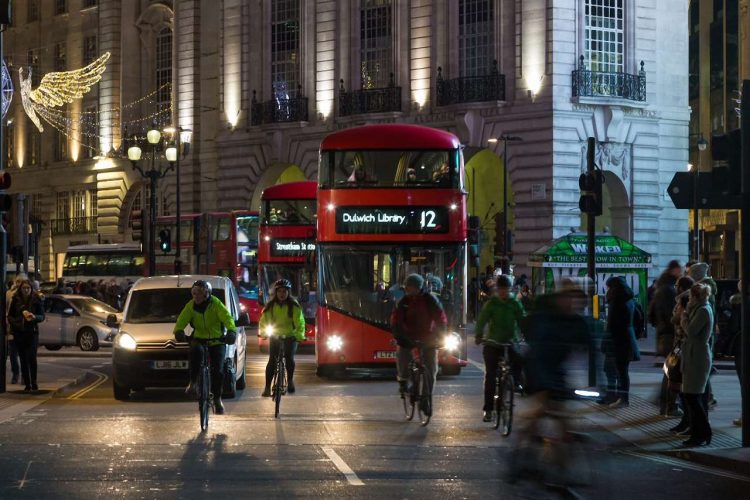Transport for London (TfL) has published a new Business Plan that details how it will support the capital’s economic recovery and become its green heartbeat whilst achieving operational financial sustainability by 2023/24.
The plan charts how, over the next three and a half years, Transport for London will play an important part in improving air quality and tackling climate change, encouraging walking and cycling, and investing in public transport.
A total of £8.1bn is earmarked for investment in London’s road and rail network, together with funding for boroughs to invest in their streets. An average of £150m per year across both operating and capital expenditure will be invested in safe and active travel, which will further expand the capital’s strategic cycle routes. It will also fund new cycleways and safer junctions to make London’s major roads safer and more attractive for pedestrians and cyclists.

From Tuesday, 29th August 2023, the London-wide Ultra Low Emission Zone will operate across all London boroughs, up to the existing Low Emission Zone boundary. The expansion will come with a £110m scrappage scheme to support those on lower incomes, the disabled, charities, and small businesses, whilst the outer London bus network will be expanded.
The Mayor’s ambition is for London to be a net zero-carbon city by 2030, and additional funding has been allocated to mitigate the effects of climate change in London’s public transport network. The aim is that by 2030 London’s bus fleet should be zero emission.
A range of improvements planned for London’s Tube, bus and rail network includes new trains to replace the ageing Piccadilly line fleet and a new fleet for the Docklands Light Railway. The Circle line has new signalling, the Four Lines Modernisation programme will be completed to provide more frequent, reliable, and faster journeys on the District, Hammersmith & City, and Metropolitan lines, as well as modernisation and expansion of Bank station.
Projects that will be financially viable within three to five years will be prioritised, and these include energy efficiency projects that will reduce Transport for London‘s operating costs and go towards meeting London’s environmental goals.

While good progress is being made with TfL’s savings target, having delivered £400m of the £730m recurring savings target set in 2019, the pressures of managing inflation and the requirements of the most recent funding agreement mean that further efficiencies are needed.
In this Business Plan, the savings target is increasing to a total of £1bn recurring savings, meaning a further £600m per year needs to be delivered by 2025/26. This will be delivered through a focus on improving efficiencies, driving improvements where possible for TfL colleagues, and an approach to continuous savings, including working together with TfL’s supply chain to make further efficiencies.
Although £400m of the £730m recurring savings target set in 2019 has been met, further efficiencies are still needed. Therefore the savings target in this Business Plan has been increased to £1bn recurring savings, meaning £600m more needs to be delivered each year by 2025/26.
The draft Transport for London Business Plan will be considered by the Transport for London Board next Wednesday, 7th December, and can be viewed at https://board.tfl.gov.uk/documents/s19197/Appendix%202%20Draft%20TfL%20Business%20Plan%202023.pdf
The Mayor of London, Sadiq Khan, said: “The past two years have been the most challenging in TfL’s history and the pandemic’s impact on TfL’s finances was devastating. But, following tough negotiations and my commitment to prioritise funding for London’s vital public transport, TfL is on track for financial stability, ridership across the network is increasing and there have been major improvements to the capital’s public transport network.
“This year we’ve seen the opening of the transformational Elizabeth line, the extension of the Overground to Barking Riverside, the completion of important upgrades to the Northern line, and I’ve unlocked additional funding to save bus services that were under threat as well as expanding the bus network in outer London. London’s transport workers continue to play an essential and much-valued role in keeping our city’s transport network safe and operating, and this is why I took the unprecedented action to support London’s lowest-paid transport workers by removing the cost of using public transport.
“It is clear there are many challenges ahead, but TfL’s Business Plan sets out how London’s world-class public transport network will continue to contribute to a better, greener and fairer city for all Londoners.”
London’s Transport Commissioner, Andy Lord, said: “The pressures of the pandemic and the financial crisis that it created put London and TfL under greater pressure than at any point in the past two decades. Now London is emerging from the pandemic, and we have funding certainty into 2024, so we can once again look to the future with optimism.
“This plan shows how we will work to achieve our vision of being the green heartbeat of London, and how we will continue on the path to financial sustainability whilst delivering real and vital improvements for the city. It will deliver new trains for the DLR and the Piccadilly line, new cycleways, the new Thames crossing at Silvertown, safer junctions, an expanded Ultra Low Emission Zone, and a new expansion of the bus network in outer London to support growth.
“With improvements like the Elizabeth line, the Overground extension to Barking Riverside and the extension of the Northern line to Battersea, we have shown the power of transport investment. With continued Government capital investment from April 2024, we can continue to support our city and make it an even better, greener, safer, and more successful place. This work is crucial to the economy of London, and will benefit the UK as a whole.”






Responses